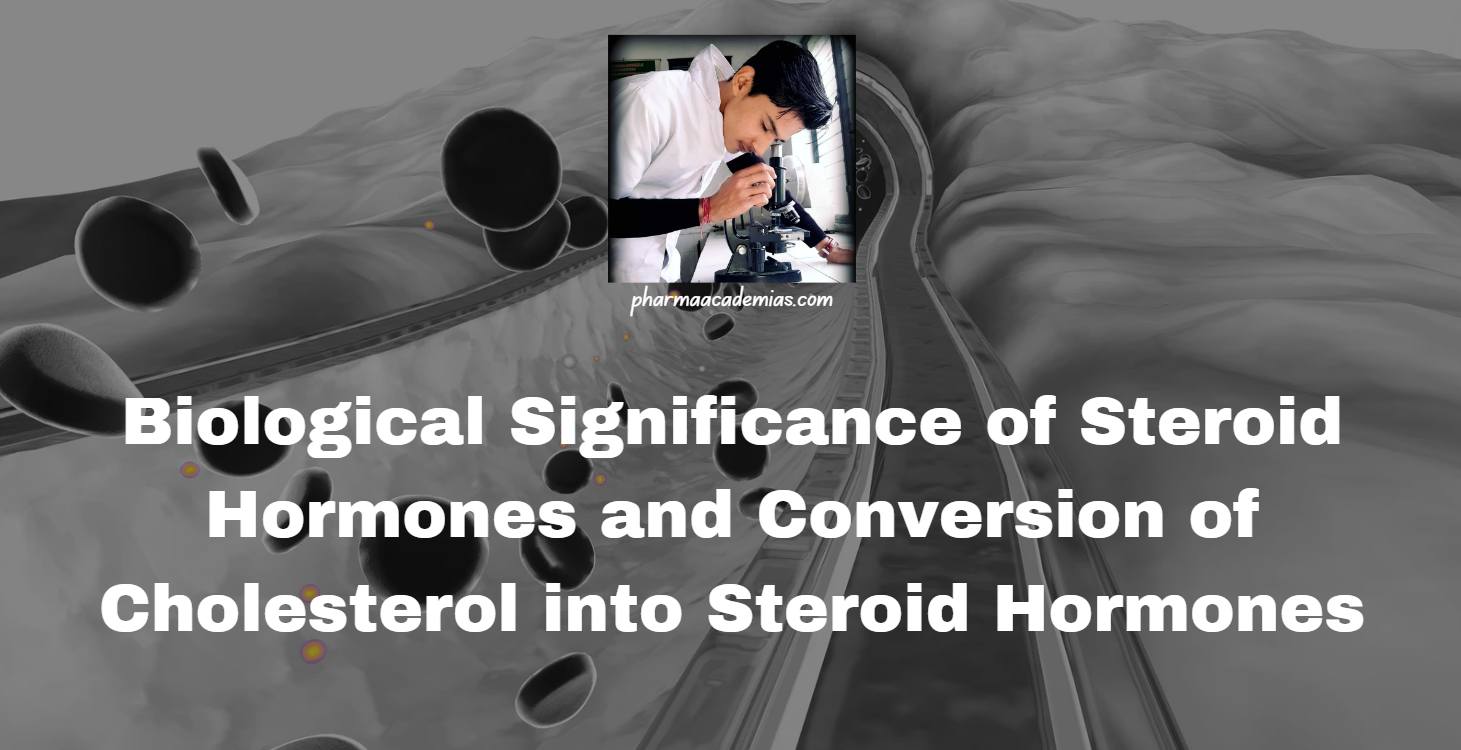Steroid hormones are a class of hormones derived from cholesterol that play crucial roles in regulating a wide range of physiological processes. They include glucocorticoids, mineralocorticoids, and sex steroids. The synthesis of these hormones from cholesterol is a complex process involving multiple enzymatic steps.
Biological Significance of Steroid Hormones
Steroid hormones exert their effects by passing through cell membranes and binding to specific intracellular receptors, leading to changes in gene expression and cellular function. Their significance includes:
1. Glucocorticoids (e.g., Cortisol)
Regulation of Metabolism: Glucocorticoids regulate carbohydrate, protein, and lipid metabolism. They promote gluconeogenesis, protein catabolism, and lipolysis, thereby increasing blood glucose levels.
Stress Response: They are critical in the body’s response to stress, maintaining homeostasis by regulating immune responses, reducing inflammation, and influencing mood and behavior.
Immune Function: Glucocorticoids have potent anti-inflammatory and immunosuppressive effects, making them important in managing autoimmune diseases and preventing excessive immune reactions.
2. Mineralocorticoids (e.g., Aldosterone)
Electrolyte and Water Balance: Aldosterone regulates sodium and potassium balance by promoting sodium reabsorption and potassium excretion in the kidneys. This process helps maintain blood pressure and fluid balance.
Blood Pressure Regulation: By controlling sodium and water retention, aldosterone plays a vital role in regulating blood volume and blood pressure.
3. Sex Steroids (e.g., Estrogens, Androgens, and Progesterone)
Reproductive Function: Sex steroids are essential for the development and function of reproductive organs. They regulate menstrual cycles, spermatogenesis, and sexual behavior.
Secondary Sexual Characteristics: These hormones are responsible for the development of secondary sexual characteristics such as breast development in females and facial hair in males.
Bone Health: Estrogens, in particular, play a crucial role in maintaining bone density and preventing osteoporosis.
Mood and Cognition: Sex steroids influence mood, cognition, and overall mental health.
Conversion of Cholesterol into Steroid Hormones
The synthesis of steroid hormones from cholesterol involves multiple steps occurring primarily in the adrenal cortex, gonads (testes and ovaries), and placenta. This process is known as steroidogenesis and involves several key enzymes.
1. Transport of Cholesterol to Mitochondria
Source of Cholesterol: Cholesterol can be synthesized de novo within the cell or taken up from circulating lipoproteins.
Transport Mechanism: Steroidogenic acute regulatory protein (StAR) facilitates the transport of cholesterol from the outer to the inner mitochondrial membrane, where the first step of steroidogenesis occurs.
2. Conversion of Cholesterol to Pregnenolone
Enzyme: Cholesterol side-chain cleavage enzyme (also known as CYP11A1 or P450scc)
Reaction:
Cholesterol + NADPH + H+ + O2 → Pregnenolone + Isocaproaldehyde + NADP+
This is the rate-limiting step in steroid hormone biosynthesis, occurring in the inner mitochondrial membrane. Pregnenolone is the common precursor for all steroid hormones.
3. Conversion of Pregnenolone to Progesterone
Enzyme: 3β-Hydroxysteroid dehydrogenase (3β-HSD)
Reaction:
Pregnenolone → Progesterone
This reaction involves the oxidation and isomerization of pregnenolone to form progesterone.
4. Pathways of Steroid Hormone Synthesis
Mineralocorticoids (Aldosterone) Pathway:
Enzyme: 21-Hydroxylase (CYP21A2)
Reaction:
Progesterone → 11-Deoxycorticosterone
Enzyme: 11β-Hydroxylase (CYP11B1)
Reaction:
11-Deoxycorticosterone → Corticosterone
Enzyme: Aldosterone synthase (CYP11B2)
Reaction:
Corticosterone → Aldosterone
Glucocorticoids (Cortisol) Pathway:
Enzyme: 17α-Hydroxylase (CYP17A1)
Reaction:
Progesterone → 17α-Hydroxyprogesterone
Enzyme: 21-Hydroxylase (CYP21A2)
Reaction:
17α-Hydroxyprogesterone → 11-Deoxycortisol
Enzyme: 11β-Hydroxylase (CYP11B1)
Reaction:
11-Deoxycortisol → Cortisol
Androgens and Estrogens Pathway:
Conversion of Pregnenolone: Pregnenolone can be converted to 17α-hydroxypregnenolone by 17α-hydroxylase (CYP17A1), and then to dehydroepiandrosterone (DHEA).
Androgen Synthesis:
DHEA Conversion: DHEA is converted to androstenedione by 3β-HSD.
Testosterone Synthesis:
Androstenedione → Testosterone
Estrogen Synthesis:
Aromatization: Testosterone is converted to estradiol by aromatase (CYP19A1).
Testosterone → Estradiol
5. Enzyme Locations:
Adrenal Cortex Zones:
Zona Glomerulosa: Produces mineralocorticoids (e.g., aldosterone).
Zona Fasciculata: Produces glucocorticoids (e.g., cortisol).
Zona Reticularis: Produces androgens (e.g., DHEA).
6. Regulation of Steroidogenesis:
ACTH (Adrenocorticotropic Hormone): Stimulates cortisol production in the adrenal cortex by increasing the expression of steroidogenic enzymes and StAR protein.
Angiotensin II and Potassium Levels: Regulate aldosterone synthesis.
LH (Luteinizing Hormone) and FSH (Follicle-Stimulating Hormone): Regulate the synthesis of sex steroids in the gonads.
Summary
Steroid hormones are vital regulators of numerous physiological processes, including metabolism, stress response, immune function, electrolyte balance, reproduction, and development. Their synthesis from cholesterol involves a series of enzymatic reactions that convert cholesterol into pregnenolone and subsequently into various steroid hormones through specific pathways. The regulation of steroidogenesis is tightly controlled by hormonal signals and feedback mechanisms to ensure proper physiological function and homeostasis.

